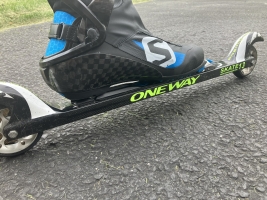Rollerskiing
It's always a good time to start rollerskiing, stay in shape and prepare for the next season. We have an email group for PACCSA rollerskiers, and a few of us meet in or near Pittsburgh most weeks. Let us know if you have any questions or if you'd like to join us!
Rollerskiing is the off-season version of cross-country skiing. Started as training method for cross-country skiers in the mid-1930s, it's now a sport in its own right (FIS recognized rollerskiing as a distinct discipline in 1992), suitable for all ages and abilities.
Rollerskis have an aluminum, fiberglass, carbon fiber or wood composite frame with one wheel (rubber or polyurethane) on each end, and are fitted with regular cross-country ski bindings. Rollerskis for skating and classic technique are different: skating rollerskis are shorter (530mm to 610mm) and mount slimmer wheels (100x24mm), while classic rollerskis are longer (650mm to 720mm) and mount larger wheels (70x40/50mm), with a ratchet system on one or both wheels to impede backward motion and allow the typical kick of classic technique.
6 Reasons Why You Should Rollerski
1. Health Benefits: Like swimming and cross-country skiing, rollerskiing is a complete sport and full body workout. It strengthens both arms, legs and core. It is great for cardio and is gentle on your knees.
2. Year Round Workout: You don’t need snow to go out and practice. No complaints about poor grooming or short winters. Despite climate change, every season is good for rollerskiing.
3. Cross-country ski technique: Rollerskiing mimics the same style and motions of cross-country skiing. “Skiers are made in the summer” says an old adage, and rollerskiing is great for practicing classic, skating and double-poling, allowing athletes to keep working on their technique, balance, coordination and endurance. All elite cross-country skiers and biathletes use rollerskiing as an integral part of their off-season training.
4. Go everywhere: Driving to your favorite ski location takes too long or is too expensive? All you need is a bike path or empty parking lot to practice rollerski. Special rollerskis with larger pneumatic wheels could also be used on crushed gravel trails.
5. It’s inexpensive: Rollerskis are cheaper than skis and are mounted with standard cross country ski bindings, so you can reuse standard boots and poles. Rollerskis last much longer than skis and don’t need replacement as kids get taller and heavier.
6. Low maintenance: Forget about waxing issues or punctures: can't get a flat with solid wheels. Also, rollerskis wheels are very durable and replacements are typically unnecessary until 1000 miles/1600 kilometers.
Other info:
Where to rollerski in and around Pittsburgh
https://xcskiworld.com/roller-skiing-guide
https://www.gearwest.com/pages/rollerski-101
https://cxcacademy.wordpress.com/tag/rollerskiing/
https://www.mansfieldnordic.org/rollerski-season-is-upon-us/
Need rollerskis? See here:
https://ffskis.com/products/rollerskis/classic-rollerskis/
https://ffskis.com/produkt/ff-active-skate/
https://rollerskishop.com/rollerskis/
https://barnett.store/collections/classic
https://barnett.store/collections/skating
https://pioneermidwest.com/collections/rollerskis-1
https://www.gearwest.com/collections/rollerskis-1
https://enjoywinter.com/read-skipost/how-to-pick-your-rollerskis-differe...
Rental is also an option! See here: https://nordicskater.com/pages/rental-roller-skis










